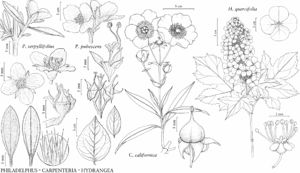Carpenteria
Proc. Amer. Assoc. Advancem. Sci. 4: 192. 1851.
| Taxon | Illustrator ⠉ | |
|---|---|---|
 | Philadelphus pubescens Carpenteria californica Hydrangea quercifolia Philadelphus serpyllifolius | John Myers Yevonn Wilson-Ramsey Yevonn Wilson-Ramsey John Myers |
Shrubs. Stems erect, ascending, or spreading. Bark exfoliating in grayish sheets or strips. Branches ascending or spreading; twigs with simple trichomes. Leaves persistent, opposite; petiole present; blade lanceolate to narrowly elliptic or oblong, herbaceous to coriaceous, margins entire or obscurely denticulate, usually revolute, sometimes plane; venation pinnate. Inflorescences terminal or axillary, cymes, 3–9 (–13) -flowered; peduncle present. Pedicels present. Flowers bisexual; perianth and androecium nearly hypogynous; hypanthium adnate to ovary proximally, free distally, patelliform, not ribbed in fruit; sepals persistent, 5–7, spreading, ovate to ovatelanceolate or triangular, sparsely to densely appressed-pubescent abaxially; petals 5–7 (–8), imbricate, spreading to reflexed, white, ovate, round, or depressed-elliptic, base sessile or obscurely clawed, surfaces glabrous; stamens 150–200; filaments distinct, essentially terete, not noticeably tapered from base to apex, apex not 2-lobed; anthers depressed-ovate; pistil 5–7-carpellate, ovary nearly superior, 5–7-locular; placentation axile proximally, parietal distally; style persistent, 1. Capsules conic to depressed-spheric, corticate to coriaceous, dehiscence basipetally septicidal to near base of fruit, delayed apically by persistent style. Seeds 50 per locule, brown or reddish-brown, ellipsoid. x = 10.
Discussion
Species 1.
Phylogenetic analyses place Carpenteria as sister to Philadelphus (L. Hufford 1997; D. E. Soltis et al. 1995) or as a clade nested within a paraphyletic Philadelphus (Guo Y. L. et al. 2013). Androecium development in the two genera is unique in Hydrangeaceae (Hufford 1998).
Selected References
Lower Taxa
"connate" is not a number. "distinct" is not a number.